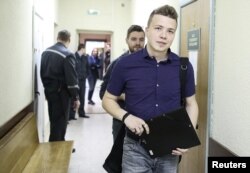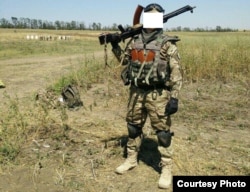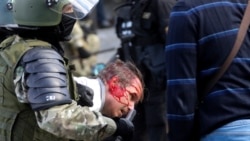Raman Pratasevich's life has been turned upside down fast.
On May 23, months after he left Belarus to avoid prosecution on incitement charges he said were trumped-up by Alyaksandr Lukashenka's government, the journalist and blogger was arrested, along with his girlfriend, after their Ryanair flight from Athens to Vilnius was diverted to Minsk following what is widely believed to have been a fake bomb threat.
Rights groups, Western governments, and Belarusians who oppose Lukashenka watched in horror as the next development unfolded: Appearances on state TV in which Pratasevich, with marks on his face and wrists, delivered what are widely considered to be coerced confessions and words of praise for Lukashenka.
Formally, authorities say Pratasevich faces charges of being behind civil disturbances, an offense punishable by up to 15 years in prison.
Informally, by Belarusian state media and others, he has been accused of fighting in the war in eastern Ukraine with the Azov Battalion, a nationalist force with neo-Nazi roots that has played a prominent role in the conflict that erupted as Kremlin-backed separatists seized parts of the Donbas in 2014.
Did he?
The answer may not matter to Lukashenka, who has used the claims to step up pressure on Pratasevich, or to the Kremlin, which has supported the crackdown next door and could only benefit from information that might discredit the jailed journalist and advance Moscow's narratives about events in Belarus and Ukraine.
At this point, there is no definitive evidence that Pratasevich fought in eastern Ukraine, where a conflict that has killed more than 13,000 people still simmers.
Pratasevich denies it. In 2020, he said that he had spent a year in the Donbas early in the war and was wounded there but he stressed that it was in a role as a journalist, not a fighter.
An Azov commander has denied Pratasevich fought in their ranks and another member of the battalion has said he was there as a photojournalist. His parents also say their son was not a combatant.
However, photos and video footage circulating on social media that appeared to show someone similar to Pratasevich in military garb and gear have fueled speculation about his role.
Russia reacted to the Euromaidan protests that pushed Moscow-friendly Ukrainian President Viktor Yanukovych from power in February 2014 by seizing control of Ukraine's Crimea region and fomenting separatism across parts of the country. War broke out between Ukrainian forces and separatists in the Donbas in April 2014, and Pratasevich traveled there sometime later in the year.
In September 2020, Pratasevich told the popular Russian YouTuber Yury Dud that he had spent a year in the Donbas covering the conflict as freelance cameraman. He said he was wounded at the front, but not as a combatant. "I didn't take part in any battles. I didn't throw Molotov [cocktails], or rocks, or whatever. I always hung back," he said.
Photos And Fatigues
The case linking Pratasevich to the Azov Battalion hinges mainly, if not entirely, on photos or videos of an individual or individuals resembling Pratasevich clothed in military fatigues, posing with weapons, standing with fighters, or being treated for a wound.
Some of the earliest claims that Pratasevich fought with Azov came from Anatoliy Shariy, a pro-Kremlin blogger in Ukraine, according to the Latvian-based media outlet Meduza.
In February 2021, Ukrainian authorities charged Shariy with treason and hate speech, and the Security Service (SBU) put him on a wanted list after he failed to show up for questioning. The SBU claims Shariy helped organize pro-Russian media campaigns, which he denies.
Shariy was among the first to point out the cover of the July 2015 edition of an online publication, Black Sun, which depicts a young man in military fatigues who resembles Pratasevich.
Some observers have said the cover photo is too grainy to determine whether it shows Pratasevich. But Oleksiy Kuzmenko, an investigative journalist and contributor to the cyber-sleuth organization Bellingcat, has written on Twitter that a facial-recognition scan determined a "high probability" the two are the same.
Others, however, have argued that it could have been Andriy Snitko, an Azov Battalion fighter who died in battle, who also seems to resemble the person on the Black Sun cover.
There are other photos as well, including one of a person who looks like Pratasevich wearing fatigues and standing with others under Azov flags at what is said to be a gathering in Mariupol, a strategically important port city on the Azov Sea, in June 2015.
Another shows someone resembling Pratasevich, standing on a dusty patch of ground in combat attire and with an automatic weapon slung over his shoulder, although it is unclear when and where this photo was taken.
The image seems to be identical to the one accompanying an interview of a man presenting himself as a Belarusian fighter in eastern Ukraine that was published by RFE/RL's Belarus Service on September 18, 2015, except that the face is blocked out in the latter.
The subject of the interview, identified only as "Kim," speaks of being wounded during fighting on March 22 of that year near the village of Shyrokyne, about 10 kilometers east of Mariupol. He said he was one of many Belarusian fighters in the so-called Pahonya detachment. He said that Pahonya, whose name is Belarusian for "pursuit," was not a separate unit and that its members served in various Ukrainian battalions.
"Kim" said he had many reasons for fighting, including having "Ukrainian blood." He said that the war in the Donbas "isn't just for Ukraine but also for Belarus," because "our country could be next if the Russian Putinist horde isn't stopped now."
Russia's seizure of Crimea and its role in the Donbas conflict raised concerns that Moscow could have designs on other former Soviet republics. In August 2015, Lukashenka voiced confidence that Russia would never go to war with Belarus but said that if anyone invaded "we would fight for every piece of land."
Ukraine's Hromadske TV posted a video on March 23, 2015, about fighting in and around Shyrokyne. The report speaks of "Azovites" in battle "against the enemy" that ended "with one volunteer wounded," and shows one person apparently being treated for wounds.
As with the grainy Black Sun cover photo, Kuzmenko has said that according to facial-recognition software there is a "high" probability the individual in the video is Pratasevich.
Others note that if the individual in the video is in fact Pratasevich, he appears to be wearing civilian clothing, potentially supporting his claim that he was not a fighter but a photojournalist.
Denials
The ranks of those who say that Pratasevich did not fight in eastern Ukraine include his parents and senior Azov Battalion members.
Former Azov commander Andriy Biletskiy, now a leader of the far-right political party National Corps, has stated on his Telegram channel that Pratasevich was at Shyrokyne as a reporter. "Raman was indeed together with Azov and other military units that fought against the occupation of Ukraine. He was with us near Shyrokyne, where we was wounded. But his weapon as a journalist was not an automatic rifle but the written word," Biletskiy wrote in a post in late May.
In a report on May 27, the Belarusian news outlet Nasha Niva quoted an unidentified fighter described as an Azov member as saying that Pratasevich did some basic training with the battalion but no actual fighting.
Crisis In Belarus
Read our coverage as Belarusian strongman Alyaksandr Lukashenka continues his brutal crackdown on NGOs, activists, and independent media following the August 2020 presidential election.
"I remember him in Urzuf," the fighter said, referring to a town near Mariupol where Azov operated a training base. "He was this young guy. Biletskiy didn't trust him because he showed up and started with, 'So where are the other Belarusians? Let me at 'em.' People figured he was collecting information, so there was never much trust and they didn't involve him in any operations. He did a bit of basic training, took some selfies with a weapon at the shooting range, and probably realized that he wouldn't be joining the team, so he left. Did he fight? If so, I don't think it was with Azov."
In an interview with Meduza, Pratasevich's mother also said that her son did not fight in eastern Ukraine. "He was there as a journalist," Natallya Pratasevich said. "All this [about him fighting] is a bunch of nonsense.... He went there as a photographer and a freelance journalist."
In remarks on May 25 to Current Time, the Russian-language network led by RFE/RL in cooperation with VOA, Pratasevich's father, Dzmitry, said that he "personally [does] not know about him fighting in the Donbas."
He also said he wanted to clarify comments he made in an earlier interview with Current Time in which he said his son had "fought on Ukraine's side."
"When there's a battle happening and a war is going on, and they're shooting all around you, do people just stand around? They're participating in war, right? He was there as a journalist, as part of a camera crew," Dzmitry Pratasevich said.
'Kim'
The identity of "Kim" remains unclear.
Asked about the 2015 interview, RFE/RL's Belarus Service Director Aleksandr Lukashuk said that the service did not know the subject's real name and received the photograph with the face already blocked out. "That's how we received that photo; anonymity for security reasons was a condition of the interviews we did with several Belarusian citizens on both sides of the conflict," he said.
The RFE/RL interview was not the only one "Kim" gave to the media. In a June 2015 interview with the Ukrainian website Focus, he said that "hundreds of Belarusians" were fighting in eastern Ukraine on both sides.
Official figures are not available. Belsat, a Polish-based satellite TV station focused on Belarus, reported in 2018 that the number of Belarusians who had fought in the Donbas may have been up to 1,000. The war continues despite cease-fires, but the fighting is much less fierce than it was in the early years of the conflict.
Pratasevich, who is now 26, was a 2017-18 Vaclav Havel Journalism fellow in Prague. The Vaclav Havel Journalism Fellowship -- a joint initiative of RFE/RL and the Czech Foreign Ministry -- is available to aspiring independent journalists in the European Union's Eastern Partnership countries and Russia.
"The first time I came across his name was in 2017 when he applied for a fellowship," Lukashuk said. He said that Pratasevich "was never associated with or worked for RFE/RL prior to or after the fellowship."
"Pratasevich and those who wrote letters supporting his nomination noted his journalistic work in eastern Ukraine. RFE/RL was not aware at the time of any accusations regarding other activities in Ukraine," said Martins Zvaners, deputy director of communications and public affairs at RFE/RL.
The Azov Battalion
The Azov Battalion was formed in the spring of 2014 by the leadership of a far-right group called Patriots of Ukraine. The Azov group's insignia features the Wolfsangel and the Black Sun, two Nazi symbols. In the early days of the conflict in eastern Ukraine, Kyiv was largely outgunned and outnumbered, with about 6,000 combat-ready troops. The government asked few questions to those ready to pick up a gun and defend the country's territorial integrity, and by early 2015 an estimated 30 volunteer militias were active in combat in eastern Ukraine.
Besides far-right ties, the militias -- along with the Moscow-backed separatists -- were implicated in possible war crimes, as Amnesty International reported.
But despite the controversy, for many Ukrainians the paramilitaries were crucial in defending the country when its formal forces were incapable. The Azov Battalion is credited with retaking control of Mariupol in June 2014.
By September 2014 the battalion was incorporated into Ukraine's National Guard, its name formally changed to Azov Regiments.
It is now a "heterogeneous radical-right social movement," according to Michael Colborne, a journalist who focuses on the far right and is writing a book about the Azov movement. "At its core, the movement encompasses the regiment itself, the National Corps political party, the Centuria (formerly the National Militia) paramilitary organization as well as a number of affiliated subgroups and initiatives including a book club, youth camps, a 'leadership school' and a (temporarily closed) three-story social center just off Kyiv's central Independence Square," Colborne wrote in an article published on June 2.
In the United States, there have been calls to have Azov designated a foreign terrorist organization (FTO), as Representative Elissa Slotkin, (Democrat-Michigan) requested in April in a letter to U.S. Secretary of State Antony Blinken.
If Pratasevich did fight with the Azov Battalion, that doesn't make him a neo-Nazi, argues Hanna Hrystenko, a Kyiv-based researcher of the far right. "Though it is true that its leaders are known for far-right beliefs and the broader Azov movement is in touch with the foreign far-right, there is no evidence that every single person [involved] shares neo-Nazi beliefs," she wrote.
Pressure On Pratasevich
Whatever the facts, Lukashenka is using claims that Pratasevich fought with the Azov Battalion in the Donbas as an added lever of pressure on him.
Several days after his arrest, the separatists who hold parts of Ukraine's Luhansk region said they wanted Pratasevich "extradited" to face charges for what they claimed without evidence were crimes committed in connection with the fighting in the Donbas.
Lukashenka seized on this, suggesting on June 1 that "investigators" from the Donbas were welcome to question Pratasevich in Minsk and hinting that punishments the people in control there might mete out could be harsher than those he faces in Belarus.
While the Belarusian authorities have not linked Pratasevich's arrest to his time in eastern Ukraine, officials and media outlets that are owned or controlled by the state have highlighted the claims, in what his supporters say is an effort to paint him as a dangerous neo-Nazi.
On May 26, Ivan Tertel, the head of the main Belarusian security agency, the KGB, asserted without providing evidence or detail that Pratasevich had "actively used" what he claimed was his fighting experience after returning to Belarus from Ukraine.
The allegations have stirred passionate debate online. Supporters of Pratasevich question their timing, saying most have appeared only after he was detained on May 23 and not last year, when Lukashenka's government put him on a "terrorist" wanted list.
Russian President Vladimir Putin has backed Lukashenka on both the broader crackdown in Belarus and the arrest of Pratasevich, telling the authoritarian leader at a meeting in Russia last week that Western criticism of the diversion of the Ryanair jet to Minsk on May 23 was an "outburst of emotions."
Russian officials, state media, and other Kremlin allies have contributed to what Anton Shekhovtsov, a Vienna-based political scientist who analyzes the actions of authoritarian governments, contended was an effort to justify the plane diversion and undermine international support for Pratasevich, in part by pushing the narrative that he is a neo-Nazi.
"While at the moment it is unclear whether Russian services participated in the Ryanair affair, it is revealing that it is Kremlin agents who are activated to justify/normalize the operation," Shekhovtsov wrote on Facebook on May 24, a day after the passenger jet was diverted to Minsk and Pratasevich was arrested at the airport.












